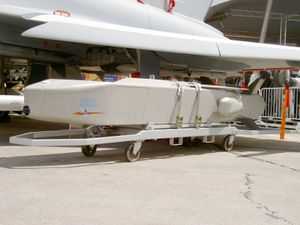KEPD 350
| TAURUS KEPD 350 | |
|---|---|
 | |
| Type | Long-range air-to-surface missile |
| Service history | |
| In service | 2005 |
| Production history | |
| Manufacturer | Taurus Systems GmbH |
| Unit cost | € 950,000 |
| Specifications | |
| Weight | 1,400 kg |
| Length | 5.1 m |
| Diameter | 1.08 m |
| Warhead | 481 kg,[1] Mephisto (Multi-Effect Penetrator, HIgh Sophisticated and Target Optimised) |
|
| |
| Engine | Williams P8300-15 Turbofan |
| Wingspan | 2.064 m |
Operational range | over 500 km[2] |
| Flight altitude | 30–40 m |
| Speed | Mach 0.80~0.95 |
Guidance system | IBN (Image Based Navigation), INS (Inertial navigation system), TRN (Terrain Referenced Navigation) and MIL-GPS (Global Positioning System) |
Launch platform | Typhoon, Tornado, Gripen, F/A-18, F-15E |
Taurus KEPD 350[lower-alpha 1] is a German/Swedish air-launched cruise missile, manufactured by Taurus Systems and used by Germany and Spain. Taurus Systems GmbH is a partnership between MBDA Deutschland GmbH (formerly LFK) and Saab Bofors Dynamics.[3]
Overview
The missile incorporates stealth characteristics and has an official range in excess of 500 kilometres (300 mi).[4] Taurus is powered by a turbofan engine at Mach 0.8~0.9 and can be carried by the Tornado, Eurofighter Typhoon, Gripen and F/A-18 aircraft.
The double 500-kilogram (1,100 lb) warhead called Mephisto (Multi-Effect Penetrator, HIgh Sophisticated and Target Optimised) features a precharge and initial penetrating charge to clear soil or enter a bunker, then a variable delay fuze to control detonation of the main warhead. The missile weighs about 1,400 kg (3,100 lb) and has a maximum body diameter of 1 metre (3.3 ft). Intended targets are hardened bunkers, command, control and communications; airfield facilities; port facilities; AMS/ammunition storage; ships in ports/at sea and bridges.
The missile also includes counter measures as a self-defence mechanism.
Mission planners program the missile with the target, air defence locations and planned ground path, then the missile uses a low terrain-hugging flight path guided by INS, IBN, TRN and GPS to the proximity of the target, although it is capable of navigating over long distances without GPS support.[5] Once there the missile commences a bunt (climb) manoeuvre to an altitude intended to achieve the best probability of target acquisition and penetration. During the cruise flight a high resolution thermographic camera (infrared homing) can support the navigation by using IBN and is also used for GPS-free target attack. The missile attempts to match a camera image with the planned 3D target model (DSMAC). If it cannot, it defaults to the other navigation systems, or, if there is a high risk of collateral damage, it will steer to a pre-designated crash point instead of risking an inaccurate attack with undesired consequences.
Taurus Systems GmbH has also proposed an anti-ship variant.[6]
Export
Spain's military bought 43 missiles. The integration of the Taurus in the Spanish Air Force service line has been certified by the successful completion of a dedicated test campaign in South Africa, carried out in May 2009.[7]
South Korea planned to order 200 missiles to integrate with their F-15K Slam Eagles after being refused Lockheed Martin's AGM-158 JASSM by Washington.[8] The Korean National Assembly had advised the government to re-evaluate plans to buy the KEPD 350 citing high costs.[9] The Defense Acquisition Program Administration (DAPA) signed the deal in November 2013. Taurus Systems will open an office in Seoul to handle various acquisition tasks and support technology-transfer and joint development of the next cruise missile. The office is will be the company's first outside of Germany, and the KEPD 350 is the first European missile to be integrated onto a Korean fighter aircraft.[10]
Taurus Systems GmbH has offered Taurus KEPD 350 to the Indian Air Force for its Sukhoi Su-30MKI fighter jets.
Operators
-
 Germany
Germany - 600 ordered for the Luftwaffe for €570 million[11] Deliveries ended in December 2010.[12]
-
 Spain
Spain - 43 ordered for the Spanish Air Force.[13] Deliveries ended in August 2010.[12] The programme cost €60m.[14]
-
 Republic of Korea
Republic of Korea - 200 ordered for the Republic of Korea Air Force for F-15K.[15][16]
See also
Notes
- ↑ Target Adaptive Unitary and Dispenser Robotic Ubiquity System/Kinetic Energy Penetrator and Destroyer.
References
- ↑ Kepd 350 (PDF), DE: Taurus systems.
- ↑ "Datasheet" (PDF), Taurus Kepd 350 (PDF), MBDA, retrieved August 30, 2013
- ↑ "Gripen Multi-Role Fighter Aircraft, Sweden". Airforce technology. Retrieved July 17, 2007. .
- ↑ "Kepd 350". DE: Taurus systems. Retrieved September 3, 2007.
- ↑ "Kepd 350". Defence Update. Retrieved May 6, 2008.
- ↑ "Germany receives last Taurus cruise missile". Flight global. Dec 14, 2010. Retrieved 2010-12-19.
- ↑ "El Ejército del Aire incrementa su capacidad operativa con la integración del misil Taurus en el F-18". Ejercito del aire (in Spanish). ES: MDE. Retrieved June 15, 2009.
- ↑ "S. Korea to buy bunker busting missiles from Europe". Reuters. April 4, 2013. Retrieved April 7, 2013.
- ↑ "Parliament advises review of Taurus, Global Hawk acquisition plan", The Korea Herald, 5 July 2013.
- ↑ "Taurus Systems to open Seoul office this week", The Korea Times, 11 May 2014.
- ↑ "Taurus". EADS. Retrieved September 11, 2007.
- ↑ 12.0 12.1 Hoyle, Craig. "Germany receives last Taurus cruise missile" Flight global, December 14, 2010. Retrieved December 14, 2010.
- ↑ Principales programas, ES: es .
- ↑ "Evaluación de los Programas Especiales de Armamento (PEAs), Ministerio de Defensa" (PDF). Atenea (in Spanish). Madrid: Grupo Atenea. September 2011. Retrieved September 30, 2012.
- ↑ "S. Korea to Buy Bunker-Buster Missiles from Europe". http://english.chosun.com/''. April 4, 2013. Retrieved April 7, 2013.
- ↑ Keck, Zachary (June 21, 2013). "South Korea to Purchase Bunker-Buster Missile". The Diplomat. Retrieved June 21, 2013.
External links
| Wikimedia Commons has media related to Taurus (missile). |